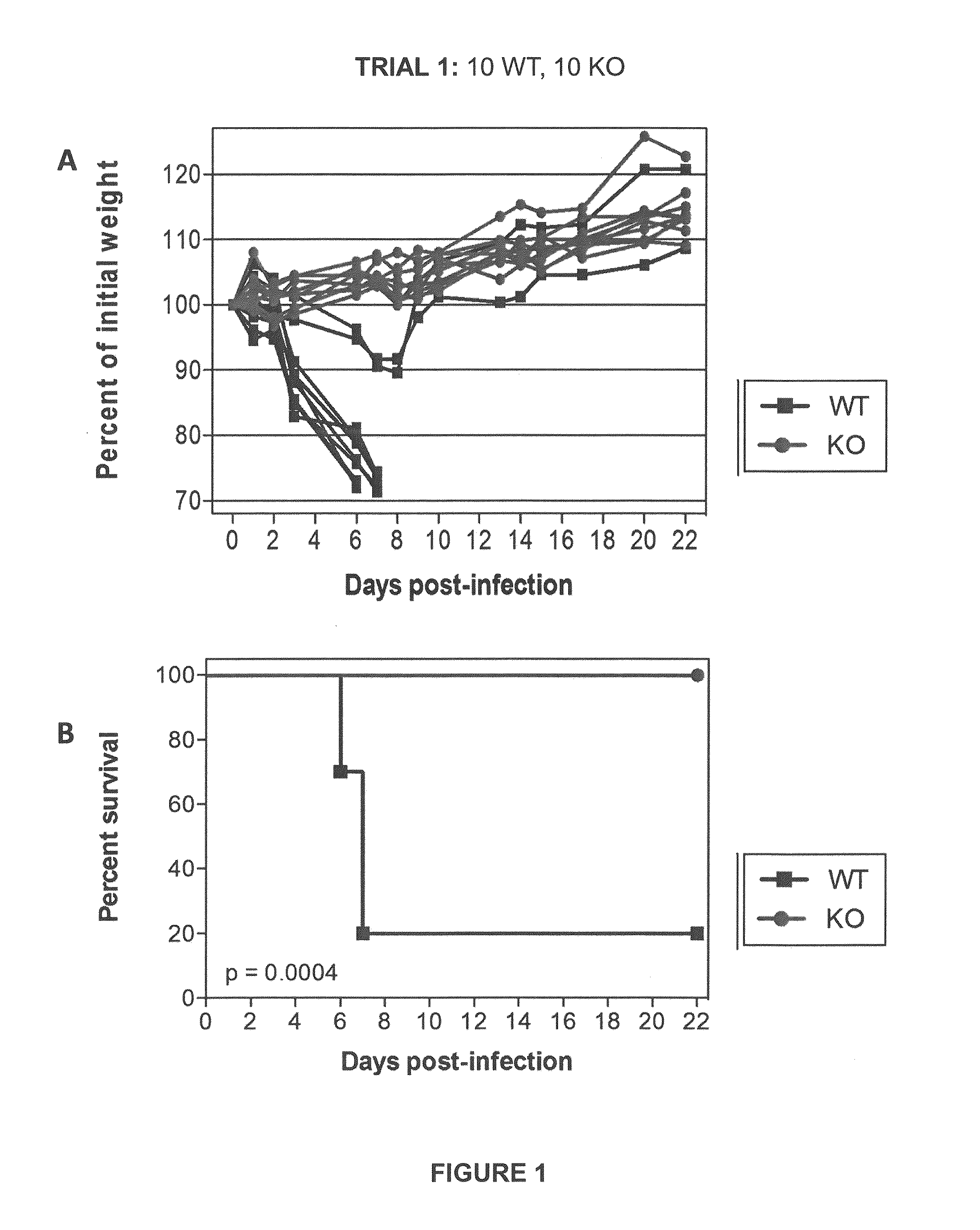Methods for treating or preventing influenza virus infection by administering a serine protease inhibitor
a serine protease inhibitor and serine protease technology, which is applied in the field of influenza virus treatment and prophylaxis, can solve the problems of not directly demonstrating the protective effect of tmprss2 in an animal model, and the use of therapeutic agents that target the proteolytic activity of tmprss2 have not been shown
- Summary
- Abstract
- Description
- Claims
- Application Information
AI Technical Summary
Benefits of technology
Problems solved by technology
Method used
Image
Examples
example 1
TMPRSS2 Knock-Out Mice Exhibit Improved Survival And Weight Maintenance Compared to Wild-Type Mice Following Influenza A Virus Infection
[0064]Initial experiments were conducted using engineered knock-out mice which fail to express a functional TMPRSS2 protein (“TMPRSS2-KO”). Wild-type littermate mice (“WT”) were used as controls. Four separate trials (Trial 1-Trial 4) were carried out in which TMPRSS2-KO mice and WT controls were infected with 10×MLD50 (750 PFUs) of A / Puerto Rico / 8 / 1934 H1N1 virus intranasally. Mice were weighed approximately each day after infection and monitored for survival. Euthanasia of infected mice occurred when the animals lost 25% or more of the initial body weight as determined at the time of infection (e.g., day 0). Mice were also monitored for other overt signs of morbidity, including hunched posture, piloerection, and / or neurological symptoms such as hind-limb paralysis. Results of Trials 1-4 are shown in FIGS. 1-4, respectively. Survival data from the ...
example 2
TMPRSS2 Knock-Out Mice Exhibit Reduced Viral Burden in the Lungs Compared to Wild-Type Mice Following Influenza A Virus Infection
[0068]In a second set of experiments, 10 TMPRSS2-KO mice and 10 WT controls were infected with 750 PFUs of A / Puerto Rico / 8 / 1934 H1N1 virus intranasally. The percent weight change and viral burden of the infected mice (expressed as PFUs in the lungs) were determined on day 5 post-infection. Results are shown in FIG. 5A (percent weight change) and 5B (viral burden).
[0069]This set of experiments again shows that TMPRSS2-KO mice exhibit overall weight gain (˜3% gain) after influenza infection, while wild-type mice exhibit significant weight loss (˜12% loss) following infection (FIG. 5A). Moreover, the viral burden in the lungs of TMPRSS2-KO mice following influenza virus infection was significantly lower (˜10,000-fold less) than what was observed in the lungs of infected wild-type mice (FIG. 5B). The results of this Example provide yet additional demonstration...
example 3
Whole-Lung Tissue Analysis and Sera Analysis of TMPRSS2 Knock-Out Mice Following Influenza A Virus Infection
[0070]In a third set of experiments, 5 TMPRSS2-KO mice and 5 WT controls were infected with 750 PFUs of A / Puerto Rico / 8 / 1934 H1N1 virus intranasally. Five uninfected wild-type and five uninfected TMPRSS2-KO mice were also included in the analyses. Mice were analyzed for: (1) weight change, (2) cellular changes via flow cytometry, (3) immunohistochemistry, PAS and H&E staining of whole lungs, and (4) cytokine levels in serum.
[0071]Percent weight change observed in the mice at 5 days post-infection is depicted in FIG. 6. TMPRSS2-KO mice infected with influenza A virus (“KO infected”) exhibited a 2.2-3.4% gain in starting weight, which was only slightly less than the weight gain that was observed in uninfected TMPRSS2-KO mice (5.9-6.4% gain) and uninfected WT mice (4.0-4.8% gain). Infected WT mice, on the other hand, exhibited significant weight loss (11.0-11.4% loss) by day 5 po...
PUM
| Property | Measurement | Unit |
|---|---|---|
| percent weight change | aaaaa | aaaaa |
| percent weight | aaaaa | aaaaa |
| frequency | aaaaa | aaaaa |
Abstract
Description
Claims
Application Information
 Login to View More
Login to View More - R&D
- Intellectual Property
- Life Sciences
- Materials
- Tech Scout
- Unparalleled Data Quality
- Higher Quality Content
- 60% Fewer Hallucinations
Browse by: Latest US Patents, China's latest patents, Technical Efficacy Thesaurus, Application Domain, Technology Topic, Popular Technical Reports.
© 2025 PatSnap. All rights reserved.Legal|Privacy policy|Modern Slavery Act Transparency Statement|Sitemap|About US| Contact US: help@patsnap.com



